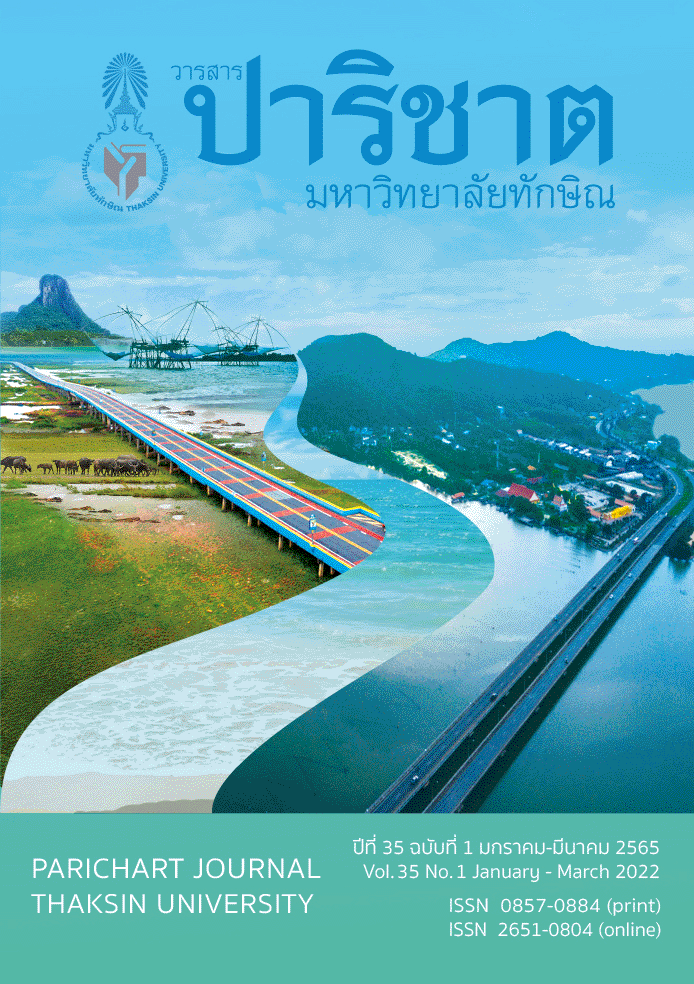A Study of Community Identity as a Guideline for Architectural Design at Palian River Basin, Trang Province
Main Article Content
Abstract
This research aimed to study of community identity in Palian Basin, Trang Province as a guideline for architectural design that promotes community tourism, literature reviews, surveying and structured interview. The research was investigated in 3 districts: -Kantang, Yantakao and Palian. The results could be presented as a guideline for an architectural design that was consistent with the community identity in order to promote the tourism. The results of the study revealed that the community in Palian River Basin, Trang Province, was geographically distinguished, especially its natural resources. The Nipa palm and mangrove forests here are the 4th most plentiful in Thailand. The way of life in the community exposes a cultural assimilation of Thai Buddhists, Thai Muslims and Chinese. In addition, according to the economy of the community, people do the fishing of Hoi Pa, called Meretrix Lusoria in science, and make products from wasted Nipa palms. The dependence between the community and the existing natural resources has brought about the environment and architectural style that contributes to the way of life. Therefore, the proposed design must focus on the living, culture and traditions of the community within the concepts of 1) natural resources in the community that seem pretty unique, 2) way of life and culture from the community resources, and 3) identity of the community i.e. material, color, pattern caused by a prominent resource in the community, which is Nipa Palm.
Article Details

This work is licensed under a Creative Commons Attribution-NonCommercial-NoDerivatives 4.0 International License.
References
Phongnak, I. (2015). Identity of U Thong Ancient City Community Suphanburi province. Silpakorn University Journal, 8(3), 511-523. (In Thai)
Ministry of Tourism & Sport. (2015). Thailand Tourism Strategy 2015-2017. (Online). Retrieved May 14, 2021, from https://www.mots.go.th/ewt_dl_link.php?nid=7114. (In Thai)
Issarathumnoon, W. (2015). Documents for Teaching in Architectural and Environmental Conservation. Bangkok: Faculty of Architecture, Chulalongkorn University. (In Thai)
Fuengfusakul, A. (2003). Identity, Theory Review and Conceptual Framework. Research Council Committee National Branch of Sociology. Bangkok: Office of the National Research Council of Thailand. (In Thai)
Meak-on, S. (2013). Impact of Tourism on Community Identity: a Case Study of the Amphawa Community. Academic Journal, Faculty of Architecture, Khon Kaen University, 12, 4. (In Thai)
Hall, E.T. (1966). The Hidden Dimension. Garden City, N.Y., Doubleday.
Horryangkun, W. (2002). Human Behavior and the Environment.(3rded.). Publisher of Chulalongkorn University. (In Thai)
Bureephakdee, C. (2012). Community Research Study. Bureau of Higher Education Standards University department. (In Thai)
Yate Mutlhae, (Interview), Satinee.W. (Interviewer), Address: Wangwon Piers, Kantang, Trang. March 16, 2018. (In Thai)
Malaom, C. (2012). Community Identity the Foundation for Education. Journal of Education, Rajabhat Maha Sarakham University, 9(1), 41. (In Thai)
Witoonsaritsilpa, W. (2005). the Construction of Thai Middle-Class Identities: a Narrative Analysis of Travel Writings [Unpublished master’s thesis]. Thammasat University. (In Thai)


